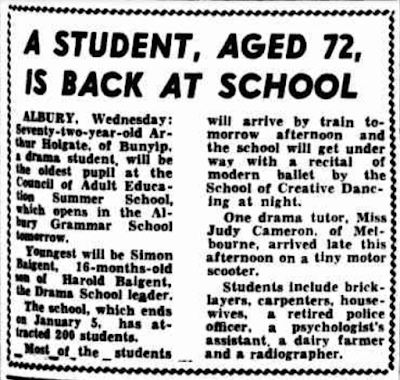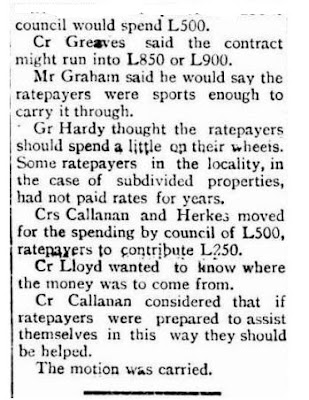The ANZ Bank in Rossiter Road is closing down in the next few weeks (May 2015) so
this is a look at the early history of the bank in
Koo-Wee-Rup. The bank started in the town 110 years ago as the London Bank, in
1920 the London Bank amalgamated with the English, Scottish & Australian Bank
(E.S. & A Bank) who in turn amalgamated with the ANZ in 1970.
The Garfield
branch of the London Bank was established in 1905 and in August 1905 an Agency had been
established at Koo-Wee-Rup and by the next year there were Agencies at Iona and
Tynong. The first manager was Clarence Adeney, described in one report as the
‘genial Mr Adeney’ and described by David Mickle as ‘a kind and gentle man’. He
retired in early 1920 and was replaced by Mr W. K Patterson.
Above: Article from South Bourke and Mornington Journal, August 16 1905
The Lang Lang Guardian reported on September 5
1906 that Mr A. Woodman had accepted a contract from the London Bank to erect a
Bank chambers and dwelling at an estimated cost of £600. The construction was
to be of oregon and plaster and it was also proposed to use tiles for the
roof. An advertisement in the same paper
in the November said the London Bank Agency had been converted into a branch
and ‘will be open daily for the transaction of all usual banking business’ – so
I believe this would have coincided with the completion of the new building.
The Bank was obviously going well as in October 1912 they
purchased the site of their building for a ‘satisfactory price’ according to
the South Bourke & Mornington
Journal.
In
1919, a ‘Receiving Agency’ was established by the bank at Dalmore - it opened
Wednesdays from 10.15am to 1.00pm.
Above: E.S. & A. Bank in Station Street, Koo-Wee-Rup c. 1940s
Below: The Lang Lang Bank
 In the October of 1919 the Koo-Wee-Rup Sun reported that The contractor for the alterations to the
London Bank at Koo-Wee-Rup has the work well in hand and will complete it in a
few weeks. It speaks well for Koo-Wee-Rup when the local bank has to enlarge
its premises. The extra room will be needed in anticipation for the next record
season. The second storey was added at this time and the banking chamber
was enlarged, a manager’s office added as well as a room upstairs to be used as
residential quarters. A strong room
was also constructed and the ‘premises were renovated throughout’.
In the October of 1919 the Koo-Wee-Rup Sun reported that The contractor for the alterations to the
London Bank at Koo-Wee-Rup has the work well in hand and will complete it in a
few weeks. It speaks well for Koo-Wee-Rup when the local bank has to enlarge
its premises. The extra room will be needed in anticipation for the next record
season. The second storey was added at this time and the banking chamber
was enlarged, a manager’s office added as well as a room upstairs to be used as
residential quarters. A strong room
was also constructed and the ‘premises were renovated throughout’.
The
works were not completed until the December owing to ‘labour trouble, strikes
and railway delays’ The architects were
Ballantyne and Hare – who designed houses in Malvern and Toorak and in 1929
Cedric Ballantyne designed the Regent
Theatre in Melbourne.
The
Cardinia Shire Heritage Study describes the Bank as an early example of the
architectural style known as ‘towards modernism’ and it is one of three former
E.S. & A Banks on the Heritage Study. The other ones are the Garfield Bank,
which was built in 1925 and the Lang Lang Bank, which was built in 1929. The
Garfield Bank is thought to have been designed by Twentyman & Askew, the
same Architects as the Lang Lang bank.
There
was an E.S & A. Agency at Cora Lynn, which was staffed about a morning a
week and closed in the early 1960s.








